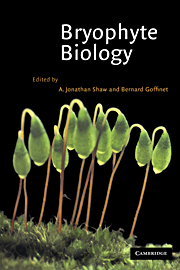Book contents
- Frontmatter
- Contents
- List of contributors
- Preface
- 1 Anatomy, development, and classification of hornworts
- 2 Morphology and classification of the Marchantiophyta
- 3 Morphology and classification of mosses
- 4 Origin and phylogenetic relationships of bryophytes
- 5 Chemical constituents and biochemistry
- 6 Molecular genetic studies of moss species
- 7 Control of morphogenesis in bryophytes
- 8 Physiological ecology
- 9 Mineral nutrition, substratum ecology, and pollution
- 10 Peatlands: ecosystems dominated by bryophytes
- 11 Role of bryophyte-dominated ecosystems in the global carbon budget
- 12 Population ecology, population genetics, and microevolution
- 13 Bryogeography and conservation of bryophytes
- Index
2 - Morphology and classification of the Marchantiophyta
Published online by Cambridge University Press: 05 June 2012
- Frontmatter
- Contents
- List of contributors
- Preface
- 1 Anatomy, development, and classification of hornworts
- 2 Morphology and classification of the Marchantiophyta
- 3 Morphology and classification of mosses
- 4 Origin and phylogenetic relationships of bryophytes
- 5 Chemical constituents and biochemistry
- 6 Molecular genetic studies of moss species
- 7 Control of morphogenesis in bryophytes
- 8 Physiological ecology
- 9 Mineral nutrition, substratum ecology, and pollution
- 10 Peatlands: ecosystems dominated by bryophytes
- 11 Role of bryophyte-dominated ecosystems in the global carbon budget
- 12 Population ecology, population genetics, and microevolution
- 13 Bryogeography and conservation of bryophytes
- Index
Summary
Introduction
Like other bryophytes, liverworts are small, herbaceous plants of terrestrial ecosystems. They share, with the mosses and hornworts, a heteromorphic life cycle in which the sporophyte is comparatively shortlived and nutritionally dependent on the free-living gametophyte, but differ from both in numerous anatomical features as detailed by Crandall-Stotler (1984). Notable among these is that their sporophytes mature completely within the confines of gametophytic tissue, without differentiation of a meristematic zone, and always lack sto mates and a columella. Gametophytes usually grow prostrate on their substrates and are of three fundamental types, 1) a leafy shoot system, 2) a simple thallus, or 3) a complex thallus, with air chambers. Traditionally, liverworts are subdivided into two major groups, the marchantioids and the jungermannioids, based somewhat on these growth forms. For example, complex thalloid organization is restricted to genera of the marchantioid group, while leafy shoot systems are the most common growth form in the jungermannioid group. Only simple thalloid morphologies are expressed in both marchantioid and jungermannioid taxa.
There are an estimated 6000 to 8000 species of liverworts, of which at least 85% are leafy jungermannioids (Schuster 1984a). In general, leafy liverworts possess fairly simple stems and two or three rows of unistratose, frequently divided leaves (Fig. 2.1). Some taxa are isophyllous, with all three rows of leaves transversely inserted, but more commonly, they are anisophyllous with a small row of transversely inserted ventral leaves, or amphigastria, and two rows of larger, obliquely inserted lateral leaves.
- Type
- Chapter
- Information
- Bryophyte Biology , pp. 21 - 70Publisher: Cambridge University PressPrint publication year: 2000
- 60
- Cited by



